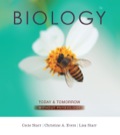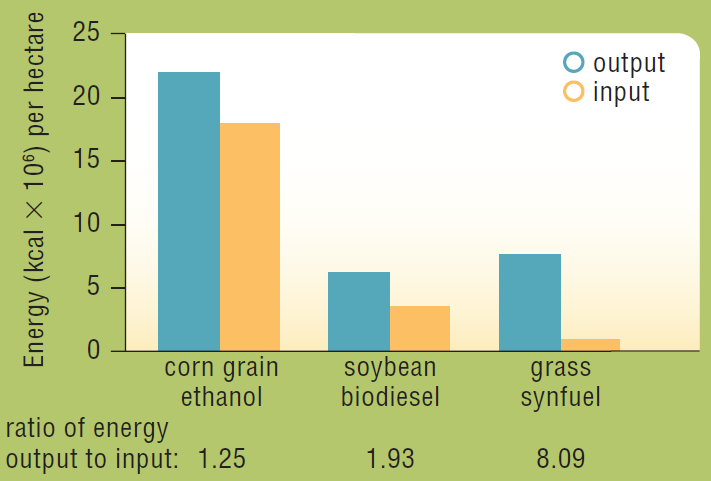
Concept explainers
Biofuels
A lot of energy is locked up in the
Corn, soy, sugarcane, and other food crops are rich in oils, starches, and sugars that can be easily converted to biofuels. The starch in corn kernels, for example, can be enzymatically broken down to glucose, which is fermented to ethanol by bacteria or yeast. However, growing food crops for biofuel production typically requires a lot of energy (in the form of fossil fuels) and it damages the environment. Making biofuels from other plant matter such as weeds or agricultural waste requires additional steps, because these materials contain a higher proportion of cellulose. Breaking down this tough carbohydrate to its glucose monomers adds cost to the biofuel product.
In 2006, David Tilman and his colleagues published the results of a 10-year study comparing the net energy output of various biofuels. The researchers made biofuel from a mixture of native perennial grasses grown without irrigation, fertilizer, pesticides, or herbicides, in sandy soil that was so depleted by intensive agriculture that it had been abandoned. The energy content of this biofuel and the energy it took to produce it were measured and compared with that of biofuels made from food crops (Figure 5.16).

Which of the three crops required the least amount of land to produce a given amount of biofuel energy?
Want to see the full answer?
Check out a sample textbook solution
Chapter 5 Solutions
EBK BIOLOGY TODAY AND TOMORROW WITHOUT
- Please hand draw everying. Thank you! Draw a gram positive bacterial cell below. Your cell should have the following parts, labeled: A coccus shape A capsule The gram positive cell wall should have the peptidoglycan labeled, as well as its component parts (NAM, NAG, and teichoic acid) A cell membrane Fimbriae A nucleoid Ribosomes Inclusionsarrow_forwardDraw a gram negative bacterial cell below. Your cell should have the following parts, labeled: A bacillus shape Fimbriae Amphitrichous flagella 2 membranes (outer and inner) The outer membrane should have lipopolysaccharide (LPS) with lipid A and O antigens Periplasmic space The thin peptidoglycan cell wall between the 2 membranes A nucleoid Ribosomes Inclusionsarrow_forwardBacterial species Cell wall type Example: S. mitis Gram positive S. epidermidis H. pylori M. bovis S. marcescens Shape and arrangement Coccus, streptococcus Drawing 0000000arrow_forward
- Draw a gram positive bacterial cell below. Your cell should have the following parts, labeled: A coccus shape A capsule The gram positive cell wall should have the peptidoglycan labeled, as well as its component parts (NAM, NAG, and teichoic acid) A cell membrane Fimbriae A nucleoid Ribosomes Inclusionsarrow_forwardwhat rank is above kingdom? order, class, phylum or domainarrow_forwardin the hierarchy of taconomic categories, with kingdom at the top, what taxon is below classarrow_forward
- Do cats fly without wings ?arrow_forwardLuke recently moved to a new apartment and wants to grow houseplants but isn't sure which room will be the best fit for them. Apply your knowledge of the scientific method to recommend a strategy for Luke to follow when determining the ideal location for houseplants in his new apartment.arrow_forwardA farmer has noticed that his soybean plants produce more beans in some years than others. He claims to always apply the same amount of fertilizer to the plants, but he suspects the difference in crop yield may have something to do with the amount of water the crops receive. The farmer has observed that the soybeans on his farm usually receive between 0 to 0.5 inches of water per day, but he is unsure of the optimal average daily amount of water with which to irrigate. 1. State a question that addresses the farmer’s problem 2. Conduct online research on “soybean crop irrigation" and record a brief summary of the findings 3. Construct a testable hypothesis and record i 4. Design an experiment to test the hypothesis and describe the procedures, variables, and data to be collected 5. What is the purpose of a control group in an experiment? What would the control groups be for each of your designed experiments in this exercise? 6. Describe the data that would be recorded in each of the…arrow_forward
- A farmer has noticed that his soybean plants produce more beans in some years than others. He claims to always apply the same amount of fertilizer to the plants, but he suspects the difference in crop yield may have something to do with the amount of water the crops receive. The farmer has observed that the soybeans on his farm usually receive between 0 to 0.5 inches of water per day, but he is unsure of the optimal average daily amount of water with which to irrigate. 1. State a question that addresses the farmer’s problem 2. Conduct online research on “soybean crop irrigation" and record a brief summary of the findings 3. Construct a testable hypothesis and record i 4. Design an experiment to test the hypothesis and describe the procedures, variables, and data to be collectedarrow_forwardA pharmaceutical company has developed a new weight loss drug for adults. Preliminary tests show that the drug seems to be fairly effective in about 75% of test subjects. The drug company thinks that the drug might be most effective in overweight individuals, but they are unsure to whom they should market the product. Use the scientific method to address the pharmaceutical company’s needs: State a research question that addresses the pharmaceutical company's problem Conduct online research on “Body Mass Index” categories and record a brief summary Construct a testable hypothesis and record in Design an experiment to test the hypothesis and describe the procedures, variables, and data to be collected What is the purpose of a control group in an experiment? What would the control groups be for each of your designed experiments in this exercise? Describe the data that would be recorded in each of the experiments you designed. Would it be classified as quantitative or…arrow_forwardPatients with multiple sclerosis frequently suffer from blurred vision. Drug X was developed to reduce blurred vision in healthy patients, but the effectiveness had not been tested on those suffering from multiple sclerosis. A study was conducted to determine if Drug X is effective at reducing blurry vision in multiple sclerosis patients. To be considered effective, a drug must reduce blurred vision by more than 30% in patients. Researchers predicted that a 20 mg dose of the drug would be effective for treating blurred vision in multiple sclerosis patients by reducing blurred vision by more than 30%. Drug X was administered to groups of multiple sclerosis patients at three doses (10 mg/day, 20 mg/day, 30 mg/day) for three weeks. A fourth group of patients was given a placebo containing no drug X for the same length of time. Vision clarity was measured for each patient before and after the three-week period using a standard vision test. The results were analyzed and graphed (See Figure…arrow_forward
 Biology Today and Tomorrow without Physiology (Mi...BiologyISBN:9781305117396Author:Cecie Starr, Christine Evers, Lisa StarrPublisher:Cengage Learning
Biology Today and Tomorrow without Physiology (Mi...BiologyISBN:9781305117396Author:Cecie Starr, Christine Evers, Lisa StarrPublisher:Cengage Learning Biology 2eBiologyISBN:9781947172517Author:Matthew Douglas, Jung Choi, Mary Ann ClarkPublisher:OpenStax
Biology 2eBiologyISBN:9781947172517Author:Matthew Douglas, Jung Choi, Mary Ann ClarkPublisher:OpenStax Concepts of BiologyBiologyISBN:9781938168116Author:Samantha Fowler, Rebecca Roush, James WisePublisher:OpenStax College
Concepts of BiologyBiologyISBN:9781938168116Author:Samantha Fowler, Rebecca Roush, James WisePublisher:OpenStax College
 Human Biology (MindTap Course List)BiologyISBN:9781305112100Author:Cecie Starr, Beverly McMillanPublisher:Cengage Learning
Human Biology (MindTap Course List)BiologyISBN:9781305112100Author:Cecie Starr, Beverly McMillanPublisher:Cengage Learning Biology: The Dynamic Science (MindTap Course List)BiologyISBN:9781305389892Author:Peter J. Russell, Paul E. Hertz, Beverly McMillanPublisher:Cengage Learning
Biology: The Dynamic Science (MindTap Course List)BiologyISBN:9781305389892Author:Peter J. Russell, Paul E. Hertz, Beverly McMillanPublisher:Cengage Learning





